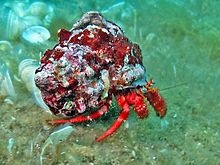| Dardanus arrosor | |
|---|---|

| |
| Dardanus arrosor from Elba | |
| Scientific classification | |
| Domain: | Eukaryota |
| Kingdom: | Animalia |
| Phylum: | Arthropoda |
| Class: | Malacostraca |
| Order: | Decapoda |
| Suborder: | Pleocyemata |
| Infraorder: | Anomura |
| Family: | Diogenidae |
| Genus: | Dardanus |
| Species: | D. arrosor |
| Binomial name | |
| Dardanus arrosor (Herbst, 1796) | |
| Synonyms | |
| |
Dardanus arrosor, the red reef hermit or Mediterranean hermit crab, is a species of hermit crab.
Description
Carapace of Dardanus arrosor can reach a length of 6–8 centimetres (2.4–3.1 in). The color varies from bright red to bright orange. The eyestalks are robust, not very long, dilated at the tip and alternately streaked with red and white. The eyes are bluish. Claws show hair-like spines and warty tubercles. The left claw is more developed than the right one, but in both claws the tip is black or yellowish. The abdomen is asymmetrical, bare and hidden within a shell.
Biology
This species breed between July and August. These crabs show the striking behavior of living within empty shells of conches (usually shells of Bittium latreillii), often decorated with sea anemones (usually Calliactis parasitica). The larvae have a symmetrical shape, but gradually they develop an asymmetrical abdomen that this crustacean will hide in a periodically replaced shell.
The relationship with the anemone is truly symbiotic, since the anemone gains scraps of food from the hermit crab, while the crab benefits from the anemone's stinging tentacles deterring predators.
This crab is an opportunistic scavenger and predator. It feeds on decaying matter, on live crabs and small fishes.
Distribution
This widespread species can be found in the Atlantic coasts, in the Mediterranean Sea, in the Red Sea, in the Indo-West Pacific (Japan, New Zealand and Philippines).
Habitat
This species inhabits continental shelf and slope. It usually lives on sandy substrate, on coastal detritic bottoms and on bathyal muds, from a few meters up to depths of 750 metres (2,460 ft).
References
- ^ WoRMS
- Türkay, M. (2001). Decapoda, in: Costello, M.J. et al. (Ed.) (2001). European register of marine species: a check-list of the marine species in Europe and a bibliography of guides to their identification. Collection Patrimoines Naturels, 50: pp. 284-292
- ^ Lesley Orson Wood,Lawson Wood Malta, Comino and Gozo: Over 80 Top Dive and Snorkel Sites Globetrotter dive guide (2nd ed.). New Holland Publishers. ISBN 978-1-84330-942-0.
- ^ Giorgifoto
- ^ Sea Life Base
- D. M. Ross, L. Sutton The Association between the Hermit Crab Dardanus arrosor (Herbst) and the Sea Anemone Calliactis parasitica (Couch)
| Taxon identifiers | |
|---|---|
| Dardanus arrosor | |